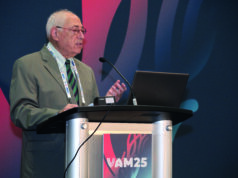A carotid endarterectomy (CEA) carried out on a 71-year-old stroke patient who tested positive for COVID-19 is highlighted in a recent case report as an example of the procedure’s safe execution under the strains of the pandemic.

Tej M. Singh, MD, a vascular surgeon with the Palo Alto Medical Foundation in Mountain View, California, et al detail the case—”Urgent carotid endarterectomy in a COVID-19 patient: Standard approach with some adjustments”—in the May issue of Vascular Disease Management.
The patient in question had been in quarantine on board a cruise ship off the coast of Japan when he developed “developed acute left-sided weakness” in early February, the authors noted. The man was then transported to a hospital in Yokohama where he was treated until discharge in early March before returning to the U.S.
A little over two weeks later, as the COVID-19 pandemic affected the hospital in Santa Clara County, California, where he would be treated, a duplex ultrasound exam “showed an 85% right internal carotid stenosis with a soft, homogeneous plaque and a mobile intramural filling defect.”
A referral by his neurologist was then made to vascular surgery, and the decision was taken to perform an urgent CEA, the authors explain.
“A standard operating approach was planned with a dedicated, experienced vascular surgery operating room team. Particular attention was paid to personal protective equipment (PPE) and procedures,” they write. “The procedure was performed in an operating room that was equipped with a separate air-circulation machine (HEPA filter) for airborne/droplet isolation, in addition to the negative pressure setting.”
In discussion, the authors considered the following question: Eight weeks post-stroke, was postponement of CEA with continued medical treatment appropriate amid the coronavirus?
Elaborating, they note: “We think not, based on the following: 1. The patient’s neurologic deficit was relatively mild (he had much to lose from recurrent stroke); 2. The duplex ultrasound findings were very compelling, suggesting high risk for embolization/thrombosis of the carotid artery with ensuing recurrent stroke and/or death.”
Concluding, the authors add: “Carotid artery endarterectomy post-COVID-19 treatment can be done safely with novel case planning, flexibility of the surgeons, attention to surgical skill/precision, team adaptability, and adaptation of the standard technical approach to ensure high-quality outcomes. A standard surgical approach paired with important safety modifications and adjustments is highly encouraged. Surgeons must be prepared, plan accordingly, and protect all involved with the care, especially the patient.”












